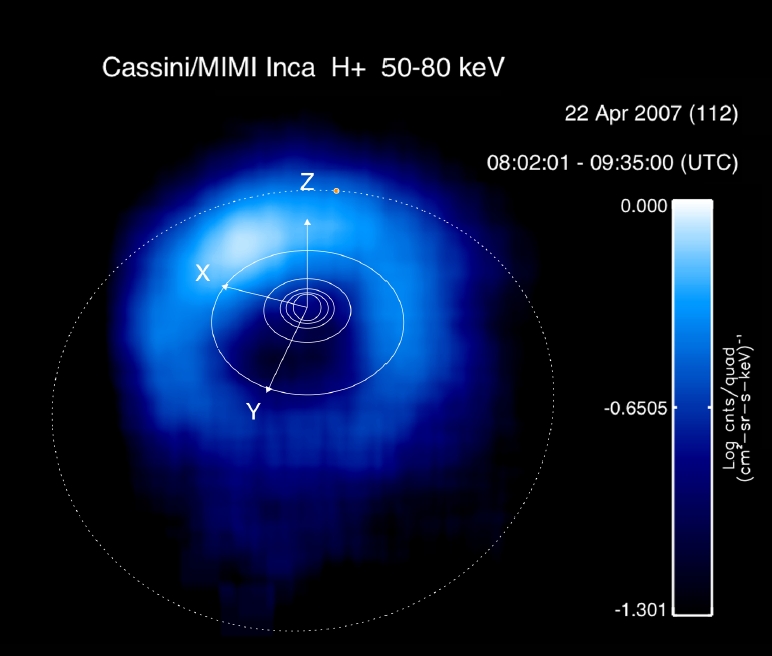Images taken by Cassini’s Magnetospheric Imaging Instrument (MIMI) show that Saturn’s ring current is a warped disc that balloons out of the equatorial plane on the planet’s dayside and remains a thin disk that rises above the plane at larger distances on the nightside.
Dr Stamatios “Tom” Krimigis, the Principal Investigator for the instrument said, “Ring currents surround planets sort of like the brim of a hat. Uniquely in Saturn’s case, that brim has been crushed at the front and tipped up at the back, so it’s pretty bent out of shape!”
The presence of a ring current around Saturn was first suggested in the early 1980s following magnetic anomalies observed by the Pioneer 11 and Voyager 1 and 2 spacecraft. Ring currents are also found around Earth and Jupiter.

A ring current at Earth was proposed by Chapman and Ferraro in the 1930s to explain the decrease in the equatorial magnetic field during geomagnetic storms; the detailed nature in terms of composition and energy content was not determined until the mid-eighties by the Active Magnetospheric Particle Tracer Explorers (AMPTE) mission, a joint programme by the US, Germany and the UK. The Principal Investigator for the AMPTE mission was Dr Krimigis. In the case of Earth, ionospheric sources dominate the formation of the ring current.

Jupiter’s ring current was first measured partially by Voyager. The Galileo mission to Jupiter added considerably to the understanding of Jupiter’s ring current, showing thatat Jupiter, Io’s volcanoes provide the gas that is subsequently ionized and accelerated.

They are caused when plasma becomes trapped between mirror points on magnetic field lines, similar to the Van Allen radiation belts surrounding Earth, and gradually drifts around the planet. The aggregate motion of all of the hot ions distributed around the equator generates an electric current. On Saturn, the source of the plasma is material from the rings and gas vented by geysers on the moon Enceladus, which is subsequently ionized and accelerated. The MIMI images show that the ring current occupies a region of the equatorial plane between 540 000 kilometres and 1 080 000 kilometres from the centre of Saturn. They also show that Saturn’s ring current is persistently asymmetric (unlike Earth’s), and that the asymmetry rotates nearly rigidly with Saturn.
MIMI, which was developed by an international team led by the Johns Hopkins University Applied Physics Laboratory (APL), Laurel, Maryland, has three distinct sensors that allow it to “visualize the invisible” and show the plasma and radiation belts in Saturn’s environment in an image. The MIMI instrument includes an Ion and Neutral Camera developed by APL, a spectrometer built by the University of Maryland, and a low energy particle detector developed by the Max-Planck-Institut fuer Sonnensystemforschung and a number of co-investigator institutions including CESR in Toulouse.
Source: European Planetology Network




Comments